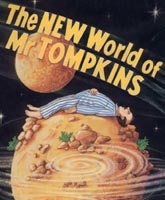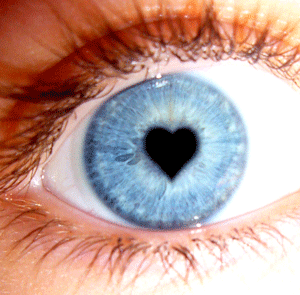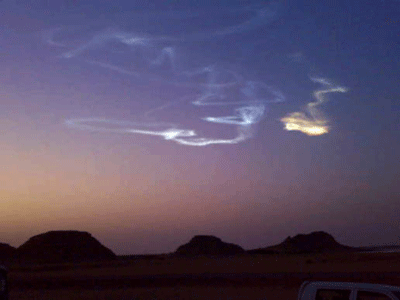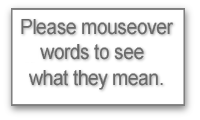Science news in brief
12-April-2009
Recent real science

The research topics below, chosen from hundreds published this week, range from love at first sight to mass extinctions in the past and possible human extinction in the future. Take a look:
5-April-2009 Making physics popular
"John Bell told me about the wife of the American ambassador to Switzerland who rolled up at his office with a dog-eared copy of The Dancing Wu Li Masters, on connections between quantum physics and Eastern mysticism. I expected the hard-nosed physicist to take a dim view of book and woman, and was startled when he did not."
6-April-2009 3-year-olds get the point
Dogs and small children who share similar social environments both seem to understand human gestures, says Gabriella Lakatos from Eötvös University in Budapest. Looking at how dogs and young children respond to adult pointing, Lakatos shows that 3-year-olds rely on the direction of the index finger to find a hidden object, while 2-year-olds and dogs respond instead to the protruding body part, even if the index finger is pointing in the opposite direction.

7-Apr-2009 Love at first sight
Leave it to geneticists to answer a question that has perplexed people since the dawn of time: Does love at first sight exist? According to a study published in the April 2009 issue of the journal Genetics, some males and females are more compatible than others, and this plays an important role in mate selection, mating outcomes, and reproductive behaviour.
8-Apr-2009 Origins of Earth's oxygen
Earth's original atmosphere had very little oxygen. This began to change 2.4 billion years ago when oxygen levels increased dramatically, during what scientists call the Great Oxidation Event. The cause has puzzled scientists, but researchers writing in Nature have found clues in ancient sedimentary rocks that dissolved nickel was the culprit..
8-Apr-2009 Near-Earth object risks and responses

What can we do about dangers from space? Apollo astronaut Rusty Schweickart will hold a public discussion at the University of Nebraska-Lincoln on protecting the Earth from asteroid impacts.
09 April 2009 Clues to life's origins
All through Earth's history, meteorites and volcanoes have caused mass extinctions. But a very old virus that lives at the bottom of the ocean may have survived all these. Crenarchaeal viruses thrive in hot, acid environments and come in diverse shapes - spheres, light-bulbs, bottles, tulips, and polyhedrons with tails.
Education resources, classroom activities, cool stuff
Near-Earth object risks and responses
"Near Earth Objects are comets and asteroids nudged by gravity into orbits that enter Earth's neighborhood." Multimedia presentation and lots of info from NASA
Asteroid tugboat. Scientific American Paper by Schweickart, Lu, Hut and Chapman.
The threat to our civilization from impacting asteroids. Chapman paper to Congress.
Asteroid deflection page by Piet Hut
The Near Earth Object Information Centre from the UK Government
The B612 Foundation.
"Earth is under constant bombardment." BBC
Asteroid and comet deflection at the wonderful Centauri Dreams website
Science of love
Women are better smellers the men, and male odours are harder to block.
How we pick mates: "Scientists have measured every shape and angle of the human face, studied symmetry, crafted formulas from the measurements of Playboy models, and had both men and women rank attractiveness based on smelling armpit sweat."
Love at first sight. Does it exist?
Transcript of 12 April 2009 podcast:
The week in Real Science: Love and space rocks.

At first sight it looks like one of those old lawyer jokes. You know the kind I mean: You're trapped in a room with a mad dog, a rattlesnake and a lawyer, and your gun has only two bullets. What do you do?
Answer? Shoot the lawyer. Twice.
Or. The trouble with the legal profession is that 99% of its members give all the others a bad name. Or … well there are loads of them. Lawers are not liked.
So what are we supposed to make of a conference for law students in Nebraska entitled Near-Earth Objects – the risks, responses and opportunities?
Stop bothering Earth
Risks and responses I can see the point of, and we'll come to them shortly. But opportunities? For lawyers?
Near-Earth objects are lumps of rock travelling at high speed, which can hit our planet and cause anything from shooting stars – by far the most common – to explosions and occasionally the destruction of most life on Earth. All depending on the size and speed of the rock.
So where's the opportunity in that for a lawyer? Is she going to slap a restraining order on the rock?
But then I took a closer look and noticed that the opening speaker at the conference is Rusty Schweickart, the Apollo mission astronaut who first piloted the lunar module in 1969, and nowadays is chairman of the B612 Foundation.
The B612
The aim of this non-profit organisation is to "alter the orbit of an asteroid in a controlled manner by 2015" – proving it can be done before it needs to be done. Because the chances that we'll be hit by a space-rock big enough to kill a large fraction of life on Earth are 100%. It will happen. It has happened. Many times. The only question is: when's the next one going to hit?
The B612 Foundation wants us to demonstrate the technology to stop it happening before astronomers searching the skies sound the alarm, and everybody starts rushing around going, "Where did I put the spaceship?" "Where's the nuclear bomb?", "Has anybody seen Bruce Willis?"
Anyway, astronauts Rusty Schweickart and Ed Lu and scientists Piet Hut and Clark Chapman founded the B612 Foundation (named for the home asteroid in the book The Little Prince) in October 2002. They also wrote a popular article called the Astronaut Tugboat for Scientific American in November 2003. Take a look at the links to these.
I'm an astronaut
I met Ed Lu a few years ago, when I was in Houston, covering a week-long visit by Scottish schoolkids to the Johnson Space Center. I was due to interview the kids, their teachers and deputy first minister Jim Wallace, and had been sent out at short notice. So I hadn't done my homework.
At dinner in the Hilton Hotel, Clear Lake, across the highway from the Space Center, I was seated next to a slightly-built, soft-spoken guy in a red T-shirt. We chatted. He asked what I did. I said I was a journalist. I asked what he did. He said he was an astronaut. "My name's Ed Lu," he told me. "I'm not long back from the International Space Station."
Later that night in a flat high up in the hotel, the Scottish contingent had laid on beer and biscuits for their NASA colleagues. It was my first night in Texas so I stepped out onto the verandah to take a look. Way below, the palm-fringed lake was silver-smooth in the moonshine. High above, a three-quarters moon was huge and bright in a star-sprinkled sky.
The door from the flat opened, briefly filling the night air with Bob Dylan, and Ed Lu joined me on the narrow verandah. Earlier that day the President had announced that NASA astronauts would be going back to the moon as a stepping-stone for human trips to Mars and beyond.
Ed Lu and I looked up at our nearest neighbour, big and pale in the dark sky, and I asked if he would like to be part of that first mission to land on its surface since 1972.
"Fly to the Moon?" he said, in a tone that implied no one in his right mind would miss that opportunity. "That would be so cool."
Where's the beef?
So anyway where's the science in all this space-rock stuff? A good way to find out, I always think, is to ask yourself: "What don't I understand?"
That takes me in two directions – the risks and responses we mentioned earlier.
I enjoyed the Bruce Willis film Armageddon – except for when he broke his promise to his daughter and died to save the Earth – but there was a lot of ropey science in that story. So the first question I had was: would blowing the rock up with nuclear explosive work? Second question, what are all the alternatives?
Take a moment to think about this yourself. Discuss it with your colleagues, make a list of all possible methods. Then, and only then, start thinking about how practical each of them is – the advantages and difficulties.
In science you always want to do that kind of thing in two stages – the creative, to generate as many ideas as possible, then the critical, the analytic.
Going nuclear
Once you've done that, take a look at what scientists and engineers say about options and practicalities. You can understand most of it with just Newton's Laws.
The B612 website doesn't discuss options. They've been through the process already and decided the tugboat is the way to go. But other links do. Start with NASA's nice multimedia presentation, the first link in our resources section, then maybe have a look at the astronaut Tugboat.
Once you've done all that, try to answer this – what are the problems with the nuclear option in Armageddon? Would it work? Are you sure?
Fancy your chances?
There's so much more to talk about but as usual we're running out of time. What about risks from a large space-rock? Well small in anyone's lifetime, certainly. You have to look not just at risks though, but also consequences. Compare an unlikely event that kills a hundred people with a very unlikely event that wipes out most life on Earth, and you get similar chances of dying.
Take a look at Clark Chapman's paper, the third link in our resources section – especially at his table of chances of dying from different causes. Notice that you've about the same chance of dying in a plane crash as from a large space-rock. Think about that. How does it compare with your chances of winning the lottery?
The human brain doesn't handle risks and consequences well. We tend to panic about small risks that are brought to our attention forcibly, and pay no attention to large ones that are far more likely to get us. But that's a subject to look at in detail another day.
Rules of attraction
Have a look at the other items this week, which are varied, interesting and often surprising. The love at first sight story is another piece of research that shows that attraction is often a sign of something happening at the level of our genes.
People who talk about chemistry in relationships are literally correct. One of the most interesting pieces of research in this area recently showed that if we like the smell of someone, it's often a sign of variety in our genes, and hence fitness in our children if we have any.
There's actually a little link between the asteroid story and the attraction story. The Little Prince from which the B612 got its name is a children's book with some profound messages. One of them in the original French (please excuse the Ayrshire accent) goes like this: "On ne voit bien qu'avec le cœur. L'essentiel est invisible pour les yeux."
"You can see clearly only with your heart. What's truly important is invisible to the eyes."
And finally
It might sound like an anti-science sort of message. But I don't believe it is.
That's all for this week at Real Science. Talk to you again soon.
Thanks for listening
Keep thinking
More help with words
atom, attract, conception, deputy, DNA, electric charge, element, fertilisation, fundamental, gene, inherit, irregularly, molecule, neutron, nucleus, offspring, particle, proton, repel, structure


